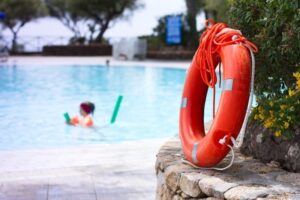
Swimming Safety: Tips and Considerations for Pools, Beaches, Hot Tubs, and More
Swimming is a great activity that is enjoyed by many across the country. Whether it's at home, the beach, or the lake, swimming is a great way to cool off during hot weather or to remain comfortable in warm climates. Many people use it as their primary source of regular exercise for its low-impact way to increase stamina and tone muscle. Although swimming is as popular as walking for exercise, it offers a number of possible dangers that people must keep in mind before they engage in the activity.
Water is everywhere, and that can make people think that it all functions more or less the same. Although people can drown in something as simple as a bathtub or hot tub given the right conditions, each body of water has its own risks and safety recommendations. Any water source can be a source of injury or even death if people do not take it seriously, particularly for infants and young children.
Attention to safety in all types of water helps people ensure that everyone in the family can have a good time without putting themselves at unnecessary risk. Adults should tailor their swimming behaviors based on the body of water, and make sure that their children do the same. Using safety equipment consistently and correctly makes it easier to protect people in more dangerous situations. Knowing what to do in case of an emergency and getting trained in basic first aid for swimming can help minimize the chance that people will end up with a serious injury.
General Swimming Safety Tips
Swimming is a popular pastime for people all over the country, but safety must remain an important part of the activity. Although infants and young children who do not know how to swim are more likely to drown, even an experienced swimmer can suffer while in the water. It is not enough for people to know the rules for the body of water in which they are swimming. They must also commit to following best practices every time they get into the water.
A day spent swimming is likely to end well if all adults are willing and able to provide supervision for themselves and children. They should plan to:
- select a day free of storms, if the water is located outside
- inspect the swimming area for possible hazards
- keep life jackets and throwing implements handy
- swim in an area with lifeguards on duty
- pay close attention to any children swimming with them
- never leave a child to monitor other children swimming
- stay within arm's reach of any untrained swimmer or child under age five
- avoid drinking alcohol or consuming other substances that inhibit concentration
- periodically check in with all swimmers to confirm they are safe
Minimizing distractions and keeping children in sight can make the experience safer and more enjoyable.
Experience swimming in a pool does not always translate accurately to swimming in natural bodies of water. Pools are generally free of rocks, branches, kelp, or other items that can tangle a swimmer. When people jump into a lake, river, or the ocean, they may contend with animals that live in or near the water. Fast-moving rivers or bodies of water with a tide can create currents that trap even a strong swimmer. Even hot tubs can pose risks. Everyone should pay close attention to the best ways to stay safe depending on the water type.
Swimming Pool Safety
Swimming in a local or home pool is a way many families enjoy warm weather. Although swimming pools are generally designed for safety, they can still be dangerous. Adults should avoid developing a false sense of security about the pool, especially if they are monitoring children. Selecting a day when the pool is not too crowded will make it easier to keep a watchful eye. People need to verify the depth of the pool before diving in, encouraging everyone to go feet-first if they are not sure. Keeping toys and electronic equipment far from the water can help avoid electrocution or accidental falls into the water.
When considering swimming pools, it is important to remember that safety starts outside of the water. Pools should be secured in a way that prevents infants and children from wandering in by accident. Inflatable pools tend to be shallower but can still present a drowning hazard. Homeowners should drain wading pools after use, and keep toys out of the water when adults are not monitoring children. The area around the pool can be a slipping hazard from splashing water, so people should be careful to walk around the edges.
Staying Safe at the Beach
Swimming in the ocean may feel as natural as it gets, but the ocean is powerful. Unpredictable waves can put talented swimmers at risk. When families decide to spend a day at the beach, they should start by researching the tide calendar for the beach. A spot comfortably close to the water at low tide may be a few feet underwater at high tide a few hours later. Although most waves come in at a fairly predictable clip, it is difficult to guarantee how the water may change with the weather or wind. People may prefer to set their belongings in dry, soft sand.
When swimming in ocean waves, people should avoid turning their back to the beach. Waves can hit surprisingly hard, and everyone must be prepared. Very young children or inexperienced swimmers may need to stay on the beach and avoid the water. People who intend to swim out into the water, away from the beach, should watch for the following changes in the geography:
- rip currents, which run under the wave but flow much faster
- rocky outcrops
- sudden drop-offs or inshore holes in the beach
People who are not expert swimmers or surfers may want to choose a time when the swells are only a few feet high.
Lakes, Rivers & Streams
Although the ocean tends to stick out in people's minds as a strong current, lakes, rivers, and streams also deserve careful consideration. These natural bodies of water may be:
- largely uncontrolled
- much colder than expected
- deeper or faster-moving than anticipated
- full of dangerous plants and wildlife
Since these water sources carry sediment and other things from other regions, they may be contaminated. People should avoid getting into the water until they can verify that it is safe for swimming. Very cold water in the spring or fall can increase the likelihood of cramping, which can render swimmers unable to get to safety. Families should keep an eye on other swimmers and watercraft, and teach children never to swim under a boat.
Shallow but quick-moving rivers and streams seem like a great place for children, but they often represent serious danger. A sudden gush of water from above can create rapids that may cause people to fall, push them against the rocks, or even force them underwater. Instead, families should have adults get into the water first and ensure that they can easily stay upright before allowing children to enter.
Hot Tubs
Before people get into a hot tub or allow their children to enter, they should heed the rules for safe hot tub use, observe the conditions each time they want to use it, and talk to people who own or maintain the system. First, they should inspect the tub to confirm that it is in good condition. A hot tub that is ready for use is:
- clean, without debris or sediment
- chlorinated to the appropriate level
- in good working order for pumping and filtering water
- 104 degrees Fahrenheit or lower
In advance of getting in the water, families should make sure that everyone who wants to get in is safe to do so. Hot tubs are not always appropriate for infants, young children, or pregnant mothers. Prolonged exposure to hot water can make some people weak or sick. To avoid communicable diseases, people should wash with soap before entering the water and avoid drinking it. Adults need to avoid alcohol or consuming other sedatives before spending time in the hot tub, as these can affect their ability to make decisions. Combined with the warm water, it may make them fall asleep.
Water Parks
Although water parks are a common part of growing up for many children, they are also a common source of injuries and drowning. Thousands of people head to the emergency room each year to attend to injuries they got from:
- slipping on wet concrete
- being thrown from a water slide
- diving into shallow wading pools
Wave pools can be much deeper than expected and may cause people to drown if the waves get too high or the pool becomes too crowded. Water parks may not have sufficient lifeguards available to monitor all swimmers. The use of life jackets or inflatables might not be adequate to mitigate drowning risk. People should avoid areas where they do not feel confident handling the water.
Children are more likely to get injured at water parks than adults. They are smaller, which means they may move faster. They are also less likely to instinctively understand how to remain safe while on a ride, or might break the safety rules. Parents should talk to each of their children about how to stay safe in different kinds of water park activities, and keep careful supervision of infants or young children.
How to Secure Your Swimming Pool When Not in Use
A significant number of injuries and drowning around home swimming pools happen when adults are not planning to swim. Properly securing the pool when it is not in use is a way to protect everyone in the neighborhood from risk, especially children and pets who live in the home. There are many different options homeowners can consider, such as fences, alarms, and covers. In most cases, homeowners may need to purchase and use a variety of protection methods. Redundancy decreases the likelihood that children will be able to get into the pool undetected.
Safety Barrier Guidelines for Home Pools
The primary form of protection that people use to protect family members from accidental access to the swimming pool is a fence. Homeowners should install a fence on all four sides of the swimming pool. Professional guidelines suggest that the barrier:
- be at least four feet tall
- have a gap four inches or less at the bottom
- use materials that children cannot easily climb
- feature bars or other materials that prevent children from climbing through
- position the latch at least 54” above the ground, to hinder small children from reaching it
- have gates that open away from the pool
- keep the gap between the gate and the fence less than 0.5”
People who want a protective fence but need the ability to remove parts of it at times may want to consider removable mesh fencing. This type of pool fence has mesh that meets the pool safety barrier guidelines. The difference is that the removable fence has poles drilled into the pool deck to support the mesh. This provides a barrier that children and pets cannot cross, but that adults can remove to access the pool.
Homeowners who are thinking about building a pool or buying a home with a pool should consider insurance liability before they make a choice. Insurance companies often look at backyard amenities like pools and trampolines as an attractive nuisance. This means the feature may draw in neighborhood children who could get injured. A simple way to minimize this is for homeowners to set clear and consistent rules for neighbors. Children should not ever be allowed to swim in the pool without adult supervision, even if they are with children who live in the house.
Many insurance companies require homeowners to install a fence around the pool with a gate that remains locked when not in use. They may also require policyholders to increase their liability insurance. Homeowners should research local rules and consult their insurance agent for more information.
Pool Alarms
Installing a fence with a gate that can be locked is the best way to prevent most people from getting in, but alarms can also help. Homeowners may want to consider installing an alarm on the gate to alert them if someone opens it or if it remains open longer than a few seconds. A fence pool motion detector can identify when someone is moving around the pool area. This type of alarm is usually less expensive than those that are mounted to the pool, but they can also be easier for children to avoid by jumping the fence.
Pool-Mounted Infrared Detectors
People can also install alarms inside the pool. These types of alarms make a sound if something that weighs about 15 pounds or more gets into the pool. The benefit to this is that people with trees hanging over the pool will not have the alarm going off every time a pine cone drops in. Since the alarm is located so close to the water, it will not go off until someone actually goes into the water. Homeowners who have larger pools may want to install more than one of these alarms.
Underwater Motion Alarms
Alarms that rely on sonar technology can be extremely effective and less likely to give a false alarm. These products are installed under the water and will sense a body 15 pounds or larger. The use of sound waves decreases the chances that the alarm will go off on a particularly windy day. On the upside, homeowners do not have to worry about setting these alarms regularly because they will remain on consistently. On the downside, this means that they will have to manually turn them off before using the pool for swimming.
Personal Immersion Detectors
Some alarm systems let homeowners know when someone has entered the pool because the sensor is on a person. At times, people will have children or pets with them while they work in the backyard or around the pool. Homeowners can attach a wristband to a child's wrist or to a pet's collar as they are in the backyard. If they fall into the pool, the alarm sounds. Since this system requires people to wear the wristband, it is not an exceptionally reliable safety approach. However, it may be useful as a secondary means of protection.
Floating Motion Sensors
People who have an above-ground pool or who want an extra way to measure movement might consider floating motion sensors. These products do not need a permanent installation on a fence or the side of a pool. As such, they can be ideal for portable pools or as an additional alarm on top of other methods. The sensors float on top of the water and set off an alert if the calm surface is disturbed. This does mean that they can return a false alarm if wind causes the water to move.
Portable or Permanent Pool Fences
A sturdy fence can eliminate access to the pool when not in use. One of the biggest risks with fences, however, is user error. If the fence gate is left open by accident, a pool or hot tub will be easily accessible. Because of this, some owners opt for fences with gates that automatically close (typically with some sort of spring in the gate's hinges).
People who have inflatable or portable pools they shut down in the fall might not want to have a pool fence installed year-round. Instead, they could use a portable pool fence. The name can be a bit of a misnomer, since the fence itself is not easily portable from one area to the next. Rather, the idea of a portable pool fence means that homeowners can install it at the beginning of the season and then take it down when they drain the pool in the fall. This approach maximizes the available space of the yard while providing adequate protection for animals and children.
Pool Covers
As a way to keep a pool clean and ready for use as well as safe, many homeowners purchase a pool cover. This cover may be made out of a hard or soft material. The ideal pool cover for safety will cover the water completely and remain closed so that people cannot lift up the cover to climb into the pool. Covers with approval from the American Society for Testing and Materials will support an adult's weight. This way, if a child or pet falls onto the cover, it will not collapse into the water.
Drain Covers
Every pool needs a drain to filter out debris and contaminants and return treated water, and each drain needs a proper cover. Drains that are uncovered may catch a swimmer's hair, clothing, or body parts. If the drain is too far underwater, the trapped person could drown. A drain cover allows for the free movement of water and minor debris without allowing children to get stuck inside it.
Pool Nets
Homeowners who cannot afford a pool cover but want to add an extra layer of protection might consider a pool net. This is a soft material that covers the entire surface area of the pool. As a benefit, it is relatively inexpensive, easy to install and quickly removed for use. However, it is also not as protective as a pool cover. Nets do not prevent debris from falling into the pool, and may still attract children and pets to try to climb on it. When used with a fence and alarms, it may be a good backup means of support.
Animal/Pet Safety Equipment
Most of the equipment that homeowners might install to protect themselves and their children can also help prevent their pets from becoming victims in the pool. In addition, people who regularly use a pool with their pets may want to install a few extra features for their benefit. These might include ramps for smaller pets that struggle to climb stairs or bridges for aquatic pets like frogs. Even pets that are good swimmers can get into trouble in a backyard swimming pool. Homeowners should use the same level of protection for pets that they would for small children.
Swimming Safety for Kids
Children often love to swim, but it can be a dangerous activity for them. Children may become overconfident in their abilities, especially if they spend a lot of time in the water. This may prompt them to try to do things in the pool that are beyond their skill or put them at risk of injury. Even children and teenagers who have passed all their swimming lessons and swim on a team may be at risk. As a result, parents should always ensure that no one swims in a pool alone or unattended. Even an expert swimmer can fall into a pool and drown or sustain serious injury.
Although teaching children how to swim and pool safety is key to ensuring that they can enjoy the sport with minimal risk, parents must always remain vigilant. There are a variety of rules that families need to follow to make safety the highest priority. Many include activities and behaviors to avoid while in or near the pool. Consistency in following the rules helps parents provide a stable influence for their children, who are more likely to obey guidelines as a result.
Facts
Keeping children safe in the water is every parent's job, but knowing how to do that takes an understanding of child development. Parents should keep the following facts in mind:
- consistent application of pool rules makes it easier for young children to remember and follow
- toddlers and young children can be taught how to swim
- infants under a year may enjoy a pool, but usually cannot keep their heads above water
- older children and teens may be more likely to try dangerous stunts in the pool
Respecting children's abilities and talents in the pool can help guide parents to the level of support they should provide for each child.
Dos
Although the whole family can enjoy their time in the water, it is on adults to pay close attention to their children the entire time they are in the pool area. Disasters happen when parents think that someone else is taking care of things. Advance preparation can help people remember to:
- designate an adult to be responsible for specific children
- aim to swim in a heated pool, or wait until the sun warms the water a little
- take a shower with soap before entering the water
- wait to swim until at least a half-hour after meals
These rules take very little time and provide a great benefit for everyone.
Don'ts
Swimming pools often feature a list of things that swimmers should avoid. These rules usually relate to safety, helping people in the pool avoid illness or injury. Parents should teach their children not to:
- expect that a group of adults will all attend to children swimming
- count on a non-swimming adult to provide adequate supervision
- drink or intentionally suck in pool water
- swim while sick
- use regular disposable or cloth diapers for swimming infants
- rely on lifeguards to provide a safe environment for children
Obeying these common-sense guidelines can minimize pool closures and help keep everyone safe for the duration of the activity.
Life Jackets
Wearing a life jacket can be a practical tool to use as part of a drowning prevention plan for people of any age or ability. As a general rule, infants, young children, and people who do not have experience swimming in the body of water should wear a life jacket. The jacket must be appropriate to the purpose and sized correctly. Life jackets that are too large for the person who wears them can actually make it harder for people to stay upright in the water.
Even experienced swimmers should wear a life jacket every time they do the following activities:
- surf or participate in other sports in the ocean or open water
- go boating or waterskiing
- engage in rafting, or kayaking
- spend time in the water near snow or ice
Consistent use of a life jacket is a matter of life and death for many people. Some adults think that they do not need a life jacket because they know how to swim. Depending on the situation, a life jacket can better ensure that a person in dangerous water or who has sustained an injury is able to get to help quickly.
How to Use a Life Jacket
People may believe that all life jackets are essentially the same, but this is not true. There are various types based on the activity, and families must ensure everyone is wearing the right kind. Before getting into the water, people should check that the life jacket:
- meets U.S. Coast Guard certifications
- works with the person who intends to use it
- can be buckled snugly and fully
- is in good condition, with no visible holes or tears
Life jackets must be used correctly every time. An unbuckled life jacket or one with loose straps can fall off or become entangled.
What to Do in an Emergency Situation
Even if people take as many precautions as they can, there is still a chance of injury or another emergency in the water. Quick action can save lives, so responsible adults must know what to do. As a general rule, experts suggest quickly scanning the area to make sure it is safe for bystanders to provide assistance. Someone trying to help should attempt to remove the injured person from the water as quickly as possible. If the water itself is dangerous due to electricity, choppy water or a fast-moving current, people may need to call 911 for assistance and keep monitoring the situation. It is better to wait for help than to create a multiple-victim situation.
Once responsible adults can remove the person from the water, they must first check for the injured party's alertness and ability to breathe. They should call the person's name or lightly shake their shoulder. If the person is unconscious, they may check the airway for breathing and try to identify a pulse on the throat just below the jaw. People who do not have a pulse may need cardiopulmonary resuscitation (CPR).
Learn CPR
CPR is a way that friends and family can help to keep a severely injured person alive until professional medical assistance arrives. There are many wrong ways to do CPR, which is why people should take training from a certified provider and retake the training at least every 1-2 years. CPR combines rescue breathing and chest compressions to help keep the body's systems functioning while help is on the way. Certification is often important for a person's ability to help. Someone who performs CPR without knowing how may cause more problems.
Learning how to do CPR correctly is a wise decision for anyone, especially people who live and work with infants, young children, or vulnerable adults. The best methods depend on the age of the person, their size, and the equipment available in the area. In any case, an adult trained in CPR should start by asking another adult to call 911 before starting the process. Minutes matter in a person's ability to survive and regain their previous level of function.
It takes practice to master CPR, and people often need a refresher training session from a qualified provider to make sure they can do it correctly. CPR for adults involves mastering the following steps:
- moving the adult to a flat surface, preferably the floor
- checking their pulse and airway for breathing
- opening their airway and providing rescue breaths
- providing chest compressions at a rate of 100-120 beats per minute
CPR is a physically demanding activity. Adults may need to trade off providing it with another trained person until help arrives. People who are certified to give CPR to adults may need to take additional training for infants and children. Smaller bodies need a different level of force in the breathing and chest compressions.
Swimming Lessons
Although people tend to focus on the importance of swimming lessons for children, they really are appropriate for people of any age. Like most sports, people can become adults without knowing how to swim due to lack of opportunity. People can learn to swim through private lessons, or as part of a small group. It is important to select instructors who are trained as lifeguards and also in swim education. Experts recommend that parents consider arranging for swimming lessons for children as young as toddler age. These children still need arms-length supervision from adults until they are older. However, introducing safe swimming practices at an early age can help children avoid developing habits that will be difficult to break.
Like any other skill, swimming safely and effectively is a talent that takes practice and periodic refreshing. People who live in areas where swimming is uncommon for most of the year may want to revisit rules and best practices for safe swimming, especially with their children. Older kids and teens who complete several levels of swimming courses may still need to avoid the most complicated swimming activities until they have confirmed they can maintain them safely.
Drowning Prevention and Facts
Although hundreds of people die as a result of drowning each year, this event is often preventable. In some cases, careful attention is all that is needed to avoid it. Drowning is:
- the most common cause of death in infants and toddlers from a preventable injury
- more likely to happen to younger children than teenagers or adults
- possible in bathtubs as well as swimming pools and open water
- typically caused by injury, inadequate swimming ability, alcohol, or health-related emergencies
The best way people can cut down on their risk of drowning is to control the risk factors. Everyone who might have access to a pool should be taught how to swim with regular verification of those skills. Parents must ensure that their children will never have access to a swimming pool without adult supervision, especially if they have a pool at home. Using a life jacket provides extra security in unfamiliar water or for untrained swimmers, but it is not a replacement for swimming lessons. People should remain awake and alert while they are swimming or monitoring others in the pool. If they cannot confirm the general safety of the pool or body of water, they should avoid getting in.
Signs of Drowning
Experts often remind swimmers that drowning usually does not look like drowning. People who are struggling to stay above the surface of the water may not have the air needed to call for help. They may bob above and under the surface as they attempt to get air. In some cases, they might look like they are swimming. This is why people should always pay attention to the people they are swimming with. Someone who is drowning can appear lethargic or make little movement at all. If they are drowning as a result of a health emergency, such as a heart attack or stroke, they may not be able to move at all.
Drowning takes very little time and can start to cause damage to the body within minutes. People should regularly check in with other swimmers and avoid getting into a pool that is overcrowded, as this can make it more difficult to monitor a fellow swimmer's behavior. People who want to help should start by throwing someone a hook or life preserver ring that the person can grab and be pulled to safety. People who are drowning may panic and pull someone underwater in an attempt to get to the surface.
Safety First
All the safety considerations surrounding swimming can make it seem like a dangerous activity. While lounging around in the hot tub as an adult tends to be a fairly safe event, taking a boat down Class 5 rapids is an entirely different story. As such, swimmers need to plan to maximize safety in whatever body of water or swimming activity they want to engage in. Going for a leisurely paddle around the family pool still requires attention, just as someone would if they were training for a triathlon in the ocean.
The best approach that anyone can take is to scope out the situation, look for hazards, and proceed accordingly. No one should swim alone, even if they are alert and good at swimming. Adults should plan who will be responsible for any children attending and avoid distractions that make it difficult for them to focus on safety. People must be ready to implement safety procedures depending on the body of water, whether that means wearing a life jacket or installing a pool fence. For more information and educational materials, consider checking out the Association of Aquatic Professionals' R.E.S.P.E.C.T. campaign.
Teaching everyone in the family to swim safely without help can ensure that anyone can get to safety in case of an emergency. Anyone who is keeping an eye on others needs to know what drowning looks like, so they can watch for it. Having one or more people in the group certified to provide CPR in the event of serious injury or drowning can decrease the likelihood that someone could die as a result of the experience. Almost anyone can enjoy swimming, but a greater awareness of all these factors makes the experience even better.





